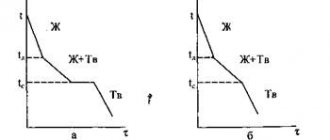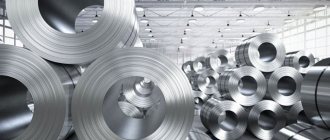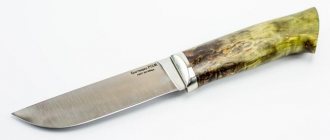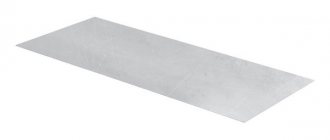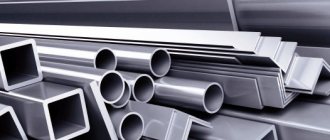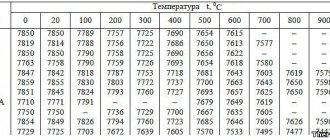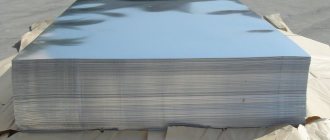Application
Steel is intended for creating building structures. This is due to high strength and reliability, and the ability to reduce metal consumption for the manufacture of elements. For example, when using a conventional alloy, the thickness of the product is 5 mm, and 09G2S is 2.5-3 mm. However, the cost of materials differs.
Read also: What are sexually transmitted diseases
Steel sheet 09G2S
The technical characteristics of the metal allow it to be used -70/+450 C. Therefore, it is intended for creating various elements and connections, and high weldability makes it possible to create complex units for the machine-building, shipbuilding, and railway industries. Heat-treated steel is used to create pipelines. In the northern regions it is used for hydrocarbon transmission.
The excellent properties of the metal make it possible to produce shaped steel - I-beams, angles, etc. The scope of application of 09G2S steel covers elements used in machine tool building, the transport industry and construction.
It is used to build fences, billboards for advertising, and small architectural forms. It is also in demand when equipping boilers.
Steel provides durability and reliability to elements used in production, transport networks, utilities, as well as in enterprises located in the northern regions. Flanges are a mass product made from steel grade 09G2S, because retain their properties when used in a wide temperature range.
Construction of a warehouse building
The popularity of metal is due to a large number of advantages, including:
- high technology;
- efficiency;
- ease of processing of welded structures;
- light weight;
- strength;
- wear resistance.
Purpose and use of steel 09G2S
The properties of the alloy make it ideal for the manufacture of welded structures. In addition, the metal is used as a coating in the manufacture of two-layer corrosion-resistant sheets.
Also made steel 09G2S
- parts for carriages;
- steam boilers;
- welded transitions, flanges;
- seamless pipes;
- pressure apparatus;
- equipment for the petrochemical industry.
In addition, steel is very popular among developers, because the high mechanical properties of the alloy and its low weight make it possible to save considerable money on the construction of commercial facilities.
Properties
Welding of steel elements is carried out by any method without preliminary surface preparation. As a result, the efficiency of using welded structures made on the basis of 09G2S structural steel is ensured.
The reason for this is the low amount of carbon in the composition. Based on many years of design experience, experts concluded that an increase in the content of this component leads to a deterioration in the quality of the weld and the formation of defects - porous structure, lack of penetration, hardened areas. After tempering, the alloy does not become brittle, and the structure remains resistant to excessive heating and the appearance of cracks in the heat-affected zone.
Steel is made using:
- open-hearth;
- electrothermal;
- converter method.
The raw material for metal production is cast iron. The properties of the alloy are improved in accordance with technology - the amount of carbon is increased and alloying additives are introduced.
Class and analogues of steel 09G2S
Class.
Low-alloy structural steel for welded structures. Some foreign analogues: 9MnSi5, 09G2S, 9SiMn16.
The offered metal meets both the requirements of GOST and international standards. Before shipment, each batch of goods undergoes a thorough check for defects, as well as compliance with the declared chemical composition. We are ready to provide all the necessary documents for rafting.
Chemical composition:
- carbon – up to 1.2%;
- silicon – 0.5-0.8%;
- manganese – 1.3-1.7%;
- nickel – up to 0.3%;
- sulfur – up to 0.04%;
- phosphorus – 0.035%;
- chromium – up to 0.3%;
- nitrogen – up to 0.008%;
- copper – up to 0.3%;
- arsenic – 0.08%.
- iron – 96-97%.
Note. Steel 09G2S can be subjected to hardening treatment: regulated or controlled rolling, accelerated cooling.
Specifications
The main technical characteristics of 09G2S steel include:
impact strength
| 590-640 kJ/m2; | |
| elongation at break | 21%; |
| turnover area | 155-255 MPa; |
| tensile strength | 343 MPa; |
| specific gravity | 7850 kg/m3; |
| welded | no limits; |
| hardness of steel 09G2S according to Brinell | 450-490 MPa. |
09G2S – chemical composition
The steel is classified as silicon-manganese. In accordance with the requirements of GOST 27772-88, it fully complies with C345 steel. The latter is used for the manufacture of building structures.
In accordance with the labeling system adopted in our country, composition 09G2S is deciphered as follows:
- carbon (C) – 0.09%;
- manganese (Mn) - 2%;
- silicon (Si) – no more than 1%.
The amount of alloying components in the steel is not so high, which is why 09G2S steel is classified as low-alloy. This alloy forms the basis of a whole family of steels. For example, - 09g2, 09g2dt, 09g2t, 10g2s and many others. The characteristics of alloys of this family are approximately similar.
Regulations
Manufactured in Russia:
- long and shaped steel according to GOST 19281-73;
- sheets and strips according to GOST 19282-73.
Among them there are angles, I-beams, sheets, etc. A large range of products allows you to select the optimal section depending on the purpose, making the solution cost-effective.
A hot-rolled sheet costs about 43 rubles/kg, and a sheet of ordinary steel costs 41-43 rubles/kg. However, the characteristics of 09G2S structural steel are several times higher than those of conventional metal.
Alloy analogues
Based on their chemical composition and mechanical properties, several similar alloys are distinguished. An analogue of steel C255 can be of domestic and foreign origin. Similar domestic brands are as follows:
- 18sp, 18Gsp and 18Gps.
- VSt3sp5 and VSt3ps6.
- St3Gps and St3Gsp.
Foreign analogues are manufactured taking into account the ISO 630 standard. This group includes the following standards:
- Fe 360-C (E 235-C).
- Fe 360-B (E 235-B).
- Fe 360-D (E 235-D).
Fe 360-B
Some analogues can be improved by thermal and chemical treatment. All alloys are characterized by high weldability and machinability.
Welding
In most cases, no preliminary preparation of the material is required. However, some technological processes involve heating the working surface to 120 degrees. Electrodes for carrying out work can be E42A, E50A, as well as a number of others. Edge cutting is carried out when the metal thickness is more than 5 mm, but even without it you can qualitatively weld parts up to 40 mm thick. Otherwise, the procedure and rules for welding work remain standard.
Semi-automatic welding is carried out at a current of 200-230 Amps and under a pressure of 2-2.2 atmospheres. After welding, cooling occurs under normal conditions; this does not affect the properties of 09G2S steel, but ensures the strength of the welded joint.
To prevent the appearance of the hardening structure, it is necessary to temper at a temperature of 600-660 degrees. After this, slow cooling occurs in the oven, which eliminates warping. If the cross-section of the part does not reach 36 mm in thickness, tempering may not be carried out.
09G2S - scope
Products made from steel 09G2S are used for the production of structures for various purposes. This is facilitated by high strength, which allows the use of thinner structural components. That is, where the thickness of the material from ordinary steel is 5 mm, then from low-alloy steel it will be 1.5 - 2 times less, and we must remember that the cost of these different steels is approximately the same.
The characteristics inherent in the 09G2S alloy make it possible to use it in the manufacture of parts and assemblies that will operate in the temperature range from -70 to +450 degrees Celsius. Weldability, which is significantly higher in comparison with other steels, makes it possible to create complex engineering structures used in shipbuilding, mechanical engineering, and railway transport. After certain types of heat treatment, this steel is used for the production of pipeline fittings. By the way, the ability of this steel to operate at temperatures of -70 degrees made it possible to use pipes made from this material for transporting hydrocarbons in the north of our country.
This steel, with its high weldability and excellent mechanical parameters, is ideal for the production of shaped products, such as beams or channels. In addition, this steel is used to produce components for the machine tool industry, transport, construction and chemical industries.
In construction, a square pipe made of 09G2S steel is widely used. Various fences are made from it, including decorative ones, advertising structures and small architectural forms are erected. This material also plays an important role in the production of boiler equipment, most of which is made from it.
It should be noted that the use of structures made of 09G2S steel allows the functioning of municipal facilities, transport systems, and industrial complexes located in regions with a harsh northern climate. For example, products such as flanges are in wide demand. Experience shows that 09G2S steel is the optimal material for their production. The fact is that they can be used both indoors and when working at various temperatures, including low ones.
The wide applicability of 09G2S steel and its analogues is explained not only by its exceptional technological properties, but, from the point of view of cost reduction, for the production of specific products. In fact, structures welded from this material are easier to process, have less weight and have good strength and wear resistance parameters.
Comparison with another steel grade
For example, for 09g2s and st3 the difference is determined primarily by the carbon content. For St3sp it is 10-20 times higher than what is found in the low-alloy alloy.
St3sp – refers to carbon alloys. This grade of steel is characterized by high brittleness and rapid destruction at low temperatures. If the brand being described has a lower limit of -70 degrees, then the object of comparison is only -20.
The quality of St3sp is ordinary, which indicates a likely high presence of sulfur and phosphorus. Then, like 09g2s is high quality. All other advantages are already in the previous description. It only remains to note that the cost of this brand is significantly higher than the price of St3sp.
Video about low alloy steels:
Areas of application
Areas of application:
- Manufacturing of parts that are subject to heavy loads - metal corners, channels, axles, beams.
- Assembly of vehicles, industrial equipment, construction of metal structures. Due to their resistance to different temperatures, the structures can be used in different climatic conditions.
- Application in the chemical industry. The material is resistant to chemicals.
- Manufacturing of poles, fences, frames for public benches, gazebos, swings, children's slides, horizontal bars.
- Production of heating equipment, steam boilers, machines for agricultural activities.
To use the material in other areas of industry, various alloying components are added to its composition.
What does the transcript look like?
Knowing the labeling makes it possible to directly understand what exactly is offered by the manufacturer and what features the product has. From a technical point of view, the marking 09g2s means the following:
- 09 - exact proportion of carbon in the total alloy;
- G2 - presence of manganese and its fluctuation in the total volume - 2%;
- C—presence of silicon, the proportion of which does not exceed 1%.
However, one should not think that the composition of steel includes only those elements that are indicated in the marking.
In addition to manganese and silicon, the overall composition is supplemented by sulfur, nitrogen, nickel, copper and phosphorus. However, the share of additional components rarely exceeds 1%, so they are not mentioned in the labeling.
Also, decoding concerns not only doping, but also other criteria. For example, the following should be included here:
- Structure and changes after the hardening process;
- Main purpose;
- Manufacturing method;
- Chem. composition of the material.
As a result, there are analogues for these indicators on the domestic market. You can often hear that 09g2s is steel 345. However, the second indicator is intended for builders and does not mean the chemical composition, but the fluidity indicator, which corresponds to the steel standard.
What is the difference between galvanized, stainless and black steel
Speaking about corrosion resistance indicators, stainless steel is preferable to galvanized and black steel; these are different categories of protection. Galvanized steel is protected from corrosion by a thin or thick layer of zinc, and stainless steel is protected by the content of alloying additives in the alloy structure. This is a big difference, because... It is easy to damage the zinc layer, revealing unprotected steel behind it. Stainless steel does not need a protective film; it is protected from the inside by its own chemical properties until the end of its service life; the absence of a coating does not affect it in any way.
Black steel has no protection at all, so it is the most susceptible to corrosion. To increase its service life, it is recommended to coat it with powder paint and process it in a polymerization oven.
By service life
The service life of working parts for each of the steels differs by a factor of two: 50 years for the first versus 25 years for the second and 10 years for the third. And these are average figures, because... Due to damage to the zinc layer, the product will most likely fail earlier. Black steel is the least wear-resistant.
Environmentally friendly
When heated or exposed to acids, zinc releases harmful compounds zinc oxide and phosphides. Poisoning can be of varying strength, including death if the damage is extensive. Stainless steel is completely safe in any product and has proven itself in the production of cookware. Ferrous metal is also not toxic, but due to its susceptibility to corrosion, it is almost always isolated from humans by a protective layer of paint.
By cost
The lower limit of the cost of 1 ton of ordinary stainless steel sheet is 113 thousand rubles. A galvanized hot-rolled sheet of the same weight can be purchased at a price of 67 thousand rubles. The price of the same sheet of black steel starts from 45 thousand rubles. The cost is also influenced by the quality characteristics of the steel and the choice of manufacturers. Read more about this in the materials on our website.
